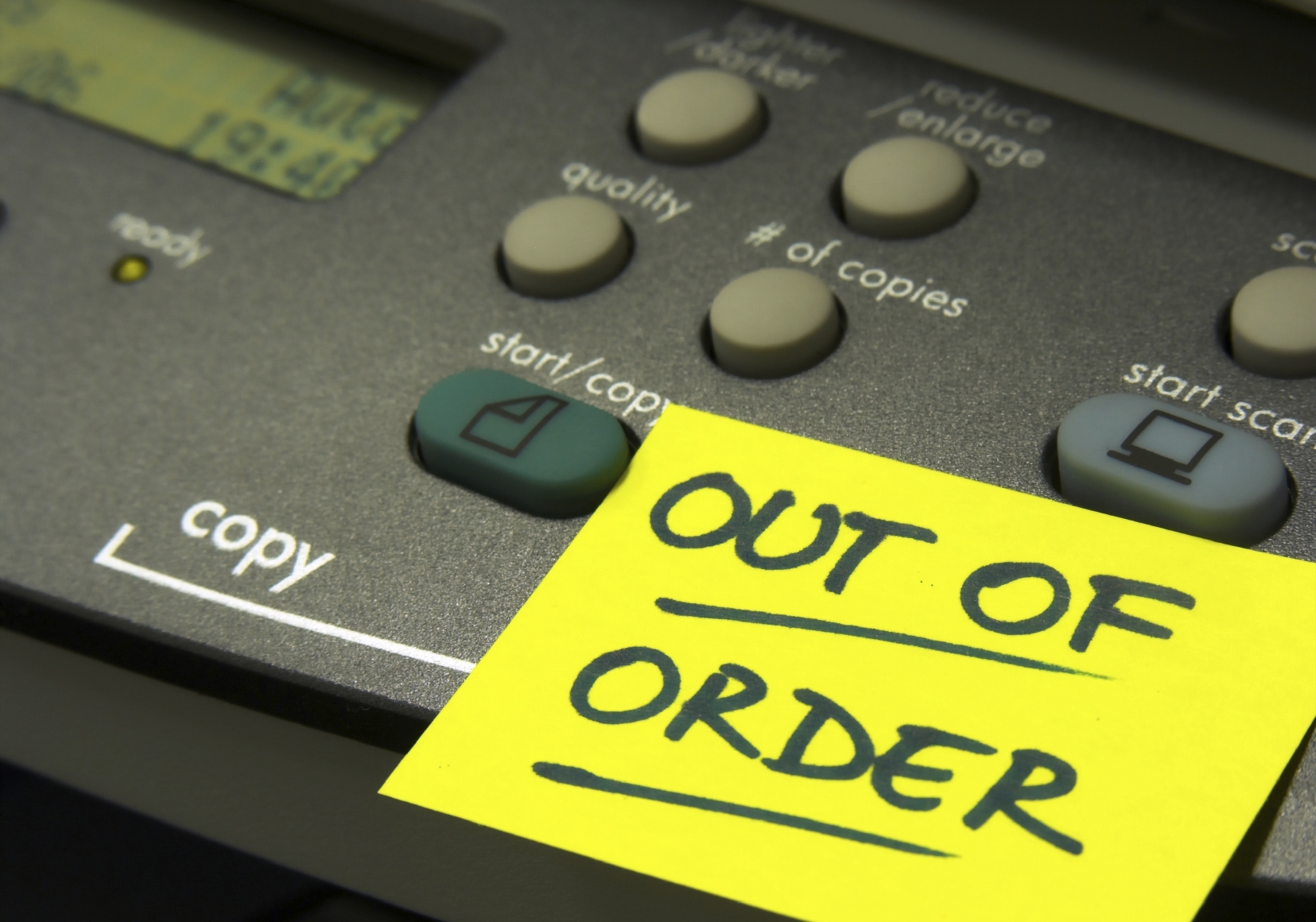I have worked in the Information Technology field for over 3 decades across every industry vertical you can think of. Business disruptions are a fact of life. I have seen and heard just about everything when it comes to customer support. There is one thing that still manages to surprise me after all this time though. The sheer number of small businesses that have not planned for a disruption to their operations.
Medium and large business are generally able to weather business disruptions more easily. Small businesses, however, are the ones most impacted by a business disruption and who need to plan for one the most. Yet most small business owners have never taken the time to consider what to do when something breaks. When it does, they lose their mind. In their universe nothing should ever wear out or break down and just because they spent money on it, it should last forever.
Be realistic
Any sane person knows that is an unrealistic view and expectation. It is still astounding to me the number of small business owners that act out and lash out to anyone and everyone they feel is to blame for their lack of planning and foresight.
“But it’s for my business!” is a common refrain. It is as if those were some magic words that when spoken will somehow, like a Jedi mind trick, instantly turn a support agent into a mindless drone and make them do whatever the business owner wants. The laws of physics, time and reality no longer apply and because they will it, they expect it to be done. Now don’t get me wrong, small business owners do not have a corner on this mindset. I have had to interact with many people in my career and life in general that believe this is how the world should work.
The Truth Hurts
The truth (as inconvenient as it may be) is…business disruptions happen. Everything used to make products or deliver services will break at some point. In other words: SHIT HAPPENS! Earth shattering information, I know. If I just knocked the wind out of you, and you need to sit down, catch your breath and process that before continuing, please do, because it is about to get even more real.
It does not matter…
The truth is that when it comes to business disruptions, all the things you think matter really don’t. It does not matter:
- How big or small your business is.
- How much money you make.
- The number of customers you have.
- That those customers are waiting for something to be completed or delivered.
- That you have deadlines or deliveries you are going to miss.
What does matter is that as an owner or agent of a business, you or the management team are responsible for keeping your business operating including when there are disruptions.
How you deal with and respond to business disruptions makes all the difference in how much, if any, money your business loses. It also makes a difference if or how your reputation suffers while you are down.
Disruptions Bring Out Bad Behaviors
The hissy fits and sob stories I have witnessed from customers after being told something they don’t want to hear are both hilarious and sad at the same time. What makes you so special that a company should bend the rules or break their policies just for you? Guess what? You are not as important as you think you are. However, if your goal is to star in your own viral video filmed by strangers so you can see your temper tantrum from several perspectives on the Internet (and maybe the news), mission accomplished.
That said, I get it. When things break or don’t go as planned, it’s stressful and can be embarrassing. It is ok to get upset, but it is not okay to take that frustration out on people trying to help you. It is something I remind myself all the time.
Complaining to Support
Whining, crying, and complaining to support of a company whose products or services you use is not going to do anything to speed up the time it takes for them to do their troubleshooting or determine to send you a replacement part or device. Your lack of planning does not constitute an emergency for them no matter how much you beg, shout or scream.
Out of Warranty
If your device is out of warranty, in most cases there is nothing they will do for you and it is up to you to go purchase a new one. It is your responsibility to know what the warranty period is and what it covers on items you purchase.
Depending on what the item is, most companies offer a warranty on items between 90 days and 1 year. Some products have a longer period but not many. Sometimes you can purchase an extended warranty to cover the item for a longer period. Many retailers have plans you can add-on at checkout when buying electronics or appliances for example. Costco, automatically adds a year to the manufacturer warranty of electronics you purchase through them. That being said, if your device breaks after this period, the manufacturer has no responsibility to you to repair or replace the device. Accept it and move on.
Emailing instead of calling / chatting
If a device is so critical to your business, why are you emailing support instead of calling? Unless email is all they offer, you need to use the phone number or live chat options.
Email is not for urgent issues. It generally takes longer to resolve a support issue via email than if you call their support directly or use the live chat. On the phone or chat they can ask you all the information they need an usually resolve the problem or have a solution by the end of the call/chat.
Email on the other hand is like a tennis match. Back and forth with the questions and answers over the course of several days or weeks. Why? Because most customers don’t know how to communicate effectively using email to get their issue resolved. People don’t read the support email carefully so they miss questions and don’t provide all the information requested. Others don’t understand the questions and provide the wrong information. That just creates more back and forth further frustrating both the customer and support agent. If the device is truly critical and calling support or chatting in is an option, use it! You will get a resolution much quicker.
Assigning Blame
“My device is broken and it’s your fault!” Wait, what? How is it the device manufacturer’s fault that your business is disrupted? Do they control how you run your business? No? Then it is your fault if you have not planned for a business disruption. Blaming others for your short-sightedness is not helping you.
Resorting to threats when you don’t get your way
Threatening a support agent is one of the quickest ways to get yourself noticed by a company, and not in a good way.
At best they may tell you where you can go or disconnect the call. They may decide that you are not worth the trouble and cancel your access or delete your account “accidentally”. You could be banned from the platform for your abusive behavior temporarily or permanently. At worst they may take legal action against you.
Just because you are upset it does not give you the right to be abusive towards the person(s) trying to help you. If you feel you have a valid case against a company then, by all means, report them to the Better Business Bureau (BBB). Threatening that or legal action just to get your way will not speed up your support ticket.
Any support agent that has a customer that acts like this puts that ticket on the bottom of their stack. Only after they take care of everyone else will your issue be looked at. That is because you do not know how to control your emotions, communicate effectively, or follow instructions. If you truly have your lawyer involved, then why are you talking with a support agent? That is their job at that point, and they will be talking with the company’s lawyers, not a support agent. Grow up.
Planning is better than panicking
Have you heard of Murphy’s Law? Anything that can go wrong will go wrong…and usually at the worst time. When things break (not if), you need to have a plan. Call it an emergency plan, backup plan, Plan B, etc. It doesn’t matter what you call it, only that you have it.
This can mean the difference in your business continuing as though nothing happened or losing customers and your reputation suffering because you were unprepared. Panicking and lashing out does nothing to fix the issues and just adds to the stress of the situation and damages your reputation both personally and professionally.
A few simple steps upfront can go a long way to alleviating issues when they occur.
1. Document your processes
Start by documenting your processes (Microsoft OneNote works great for this). This is going to have several benefits.
First, it forces you to really think about what you are doing and how you are doing it. This is also the first step in the continuous improvement process. Figuring out ways to do the same thing better, faster and/or more efficiently than you are currently doing them can save time, energy, reduce expenses and improve your bottom line.
Second, it becomes your operations binder that you can use when your business expands and you have to train new employees on your processes. It can also be used if you get sick, hospitalized, or decide to take a vacation and have someone run things for a few days or weeks in your absence.
Third, it helps you identify points of failure. If ‘X’ breaks down, or stops working, how does this impact my business? ‘X’ is everything from your computer and Internet connection to software programs, cloud services like Microsoft 365 and social media sites, devices like printers, lights, microphones, cameras or crafting machines, and even your cell phone. Whatever is needed to make the products or deliver the services you are selling.
Now you can probably come up with a pretty good list of ‘X’ items without documenting all your processes. You do run the risk of forgetting something crucial in a little used process until it breaks or you need someone else to step in and then your back in panic mode trying to address it.
2. Rank your points of failure
Once you have your list of potential points of failure, it is time to rank them in descending order of priority. That means the most critical item is first and the least critical item is last. This is a risk tolerance exercise. How much risk are you willing to take?
These items are also sometimes referred to as being in the critical path. Meaning you cannot complete the process or project if ‘X’ is not available thus jeopardizing due dates, deliveries or project timelines (not to mention your reputation and bottom line).
3. Develop mitigation plans
After prioritization, you need to determine how you continue operating while ‘X’ is unavailable.
- What redundancy can you implement to minimize outages?
- Are there work-arounds that can be used temporarily until ‘X’ is available again?
If ‘X’ is a device then having a second one as a backup is a must. If ‘X’ is service there may or may not be anything you can do about it, but at least you know that ahead of time and can respond proactively to your customers when something happens.
Devices
For devices in the critical path, the most obvious solution is to have backups to those devices. If you use a crafting machine or 3D printer to make things to sell online then you need to have a minimum of 2 of them, not just one. Having a second device gives you choices. It can…
- Double your output.
- Reduce how long you spend making products each day.
- Sit on the shelf as a backup until the primary one stops working.
The biggest benefit and reason for a second device is that it keeps you operational if one of them breaks down (and eventually it will). Then while you are contacting support about getting the primary one fixed, you can continue to make products on your second/backup device and not have a business disruption. And the backup device doesn’t have to be brand new or the same as the primary as long as it can still do what you need it to do until your main device is working again.
Examples
If you run a podcast or streaming channel on YouTube or Twitch having a backup microphone and camera is essential if one breaks or stops working for any reason.
If you are a photographer, keep your first camera package around when you upgrade to a newer package. Each time you upgrade, keep your most recent one as your backup.
Not all devices need a backup
While it makes sense to have a second/backup of most devices, not all devices need a backup standing by. I’m referring to your cell phone. You cannot have two phones with the same number so it does not make sense to have an extra one laying around. Just make sure you are backing it up on a regular basis. I recommend monthly at the very least, if not weekly or daily, depending on how much content you create using it. That way if your phone breaks or gets lost or stolen, you can get a replacement device and restore from your most recent backup. You may lose a few days or weeks of content created since the last backup but it is better than losing all your data and photos.
A laptop is also another device you can replace fairly easily if it breaks or is lost/stolen. With how quickly technology changes, the new device will most likely have newer, faster components than the device it replaced. The bigger question is do you have a backup of your local data that can be restored on a new laptop? Just like a cell phone this needs to be backed up regularly if you store data locally. If you store data online with OneDrive, Google Drive, Dropbox or another cloud service, you’re backup is the cloud and you can easily access and download your data on the new laptop. That said, I still make an offline backup of all my OneDrive data to a portable SSD on a quarterly basis.
Services
With services, this is not as cut and dry as devices since most small businesses do not have any direct control over outages or disruptions with services they use. Most of these companies have their own redundancy and contingency plans already to minimize disruptions to their services.
Internet
Internet access is a requirement for business these days. Websites, social media, email, online meetings, etc. all use Internet. So what do you do if you lose Internet? Some might enjoy the unplanned unplug but most will see their stress levels rise if they can’t access files or their website, contact their audience, etc. Ask yourself, can you…
- Continue to work offline until it comes back?
- Work through apps on your cell phone temporarily?
- Use your cell phone as a hotspot for your laptop?
- Use free WiFi at a Starbucks, Panera Bread or other location for a few hours?
These days there are always options if your Internet connection is temporarily disrupted. If you have spotty Internet in your area, consider getting a cellular Wifi hotspot to fill during those times when your main Internet connection is acting up.
Online Services
If you use online or cloud based services like Microsoft 365 or Google Suite, you are more limited in your options. With Microsoft, the core applications Excel, OneNote, PowerPoint and Word can be used on a PC offline. If you need some of the products that are only available in a web browser like Google Docs, you are out of luck until the company restores the service or your Internet comes back. The good news is that the major tech companies have engineered their systems with extremely resilient architecture to minimize any business disruptions from occurring or lasting very long.
Microsoft OneDrive allows you to work with locally stored copies of files and will update the online version once service is restored. If you do not have a file synchronized locally, however, you will not have access to it.
If you run a website through a hosting provider, it should be a rare occurrence to experience downtime. These companies are built using every redundancy available to ensure uptime for their customers. It doesn’t eliminate it completely but ensures that it is a rare occurrence.
Social Media
However you feel personally about social media, it is crucial for businesses today to use it. The good news is that if one service is experiencing a disruption, the others are usually still available. Most businesses use more than one platform to promote their goods and services. An outage or disruption at one should not impact their business much, if at all, because they can still utilize the other platforms to reach their audience.
“Buts”
Now I can already predict some of the comments this article will generate. If I struck a nerve or two, I apologize. Take some time to reflect on why it did and how you want to be perceived going forward.
“But I can’t afford a second device”
Really? How many streaming services do you subscribe to? Do you have to have Starbucks everyday or several times each week? How many meals are delivered to your door from restaurants each week? It is none of my business, but you need to be honest with yourself and decide what is more important when running a small business.
- Can you afford not to have a backup device?
- Do you not have a budget?
- Have you set nothing aside for taxes and an emergency fund?
- How much business will you lose while you are down?
- How far behind will you get if you have to wait several days or a week for a replacement part or device?
- Can your business survive the reputation hit if you are unable to meet deadlines or delivery dates?
If it is truly a business and you are receiving orders for your goods or services you should be making money. You need to reinvest some of that money back into the business including contingencies such as a device breaking down. If your priorities are splurging on yourself over ensuring your business can stay operational, you won’t be in business long.
If you are just starting out and don’t have a lot of customers yet, you can get by with a single device. Just realize that is a single point of failure and critical to your ability to fulfil orders and make money. At some point you need to address this as your business grows.
“But this device was expensive and should not break down”
Should a Nokia phone or Windows 95 PC from the 90s still work today? It cost me $1000 to replace the tires on my truck so they should last forever right? How come I needed replacement tires to begin with? I paid $28,000 for my SUV so surely that means it should last forever and never break down or need any maintenance. That is not how it works, but the sad truth is there are people that believe this.
The reality is that spending a couple hundred to a couple thousand dollars on a 3D printer or crafting machine does not mean it will last forever and never break down. It does not matter how much something costs, nothing is immune to wear and tear. Eventually everything wears out, breaks down, or does not function like it did when it was new. If it lasted forever, why do you need a new cell phone every two years or buy new cars or new clothes? In fact why do you need to buy anything other than food once you own something? Hopefully you understand how ridiculous that kind of thinking is.
“But I barely used it”
Your feeling about how much you have used the device is very subjective and irrelevant. How do you even quantify that? 1 time, 5 times? 1 time a week but it’s been 52 weeks? And is that 1 time for 30 minutes or 1 time for 8 hours (for 52 weeks)? This is never a good argument to make. Unless you literally just bought the device and it was broken out of the box or after the first time you use it, don’t do it.
“But I have good Internet!”
This is another claim I’ve heard numerous times when troubleshooting a reported issue on a client’s PC. Most people have absolutely no idea what kind of Internet they have, let alone the speeds they are getting. Somehow, because it works to surf the web and check email, it just has to be good enough for everything. Others feel it is good just based on how much they pay each month without actually knowing the speeds they are paying for. Some even associate the Internet with the performance of their PC or device and if either is not working, it is the Internet’s fault.
The bottom line is that regardless of what you feel, believe or know you have, if a support agent asks you to run a speed test, it is because they can’t just take your word for it. They need evidence of your download and upload speeds and latency (ping) to document in the ticket you opened. Just run the speed test. It takes less than a minute. Take a screenshot and submit it. See that wasn’t so hard.
I have a whole article dedicated to Internet connectivity you can read here.
Summary
Business disruptions happen. I hope by now you recognize that it is your responsibility as a small business owner or agent to make sure that not only does your business have the tools, equipment and services it needs to function, but that you actually understand what those tools, equipment and services do, how to use them correctly, and that sometimes they will break. It is also your responsibility to have contingency plans for when things do break and not revert back into a 2 year old because things are not going your way. Enough said.
Comments?
Did I miss anything or want to share your perspective? Let me know in the comments.
Last Updated on August 19, 2022




